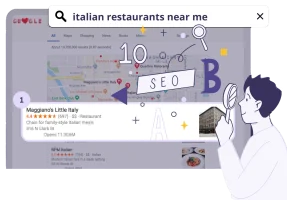Restaurants everywhere are searching for that single edge to keep tables full and buzz alive. Yet, research shows that increasing customer retention rates by just 5 percent can boost profits by anywhere from 25 to 95 percent. Most people would bet on complex advertising campaigns to achieve this. But the real secret lies in creating extraordinary experiences and clever collaborations that get people talking and coming back for more.
Quick summary
Takeaway | Explanation |
|---|---|
Host immersive themed events. | Themed nights can attract customers and create memorable experiences through unique dining themes and detailed execution. |
Leverage engaging social media challenges. | Create interactive food-related challenges to enhance visibility and encourage participation, especially among younger audiences. |
Collaborate with local businesses. | Strategic partnerships can broaden customer reach and enhance community engagement, creating unique dining experiences for patrons. |
Introduce limited-time menu items. | Scarcity can drive customer urgency and engagement, encouraging immediate visits to try exclusive culinary offerings. |
Host themed night events to engage customers
Themed night events transform ordinary dining experiences into memorable adventures that attract and retain customers. By creating unique and immersive environments, restaurants can differentiate themselves in a competitive market and generate significant buzz. Our comprehensive guide on restaurant events provides deeper insights into crafting extraordinary dining experiences. Successful themed nights require careful planning and creative execution. Consider developing events that align with your restaurant’s cuisine, ambience, and target demographic. Popular themes might include:
International cuisine nights highlighting specific regional cooking styles
Historical era celebrations featuring period-appropriate music and decor
Pop culture themed evenings inspired by movies, television shows, or music genres

The key to a remarkable themed event is authenticity and attention to detail. This means not just changing your menu, but fully committing to the experience. Staff costumes, specially crafted cocktails, background music, and decorative elements all contribute to creating an immersive atmosphere that guests will remember and discuss long after the evening concludes.
With a smart event management system, you can effortlessly plan, promote, and manage themed nights, handling reservations, guest lists, and follow-up campaigns that keep customers coming back.
Leverage social media challenges for visibility
Social media challenges have emerged as a powerful marketing strategy for restaurants seeking to amplify their online presence and engage with younger demographics. By creating interactive and shareable digital experiences, restaurants can generate organic reach and attract potential customers through viral content. Learn more about influencer marketing strategies to complement these social media initiatives. Successful social media challenges often revolve around food, creativity, and user participation. Restaurants can design challenges that encourage customers to interact with their brand in memorable ways, such as:
Creating unique food combinations or plating designs
Sharing personal dining experiences with specific hashtags
Participating in recipe creation or taste testing competitions
Collaborate with local businesses for mutual benefits
Cross-promotion strategies with local businesses represent a powerful approach to expanding restaurant visibility and creating unique customer experiences. Strategic partnerships can transform traditional marketing approaches by pooling resources and reaching broader audiences. Discover more about supporting local suppliers to enhance your collaborative efforts. Successful collaborations require identifying complementary local businesses that share similar target demographics. Potential partnership opportunities include:
Craft breweries offering exclusive beer pairings with restaurant menus
Local wineries hosting tasting events in restaurant spaces
Bakeries creating special dessert collaborations

The most innovative loyalty programs go beyond traditional point accumulation. Digital integration plays a crucial role in modern customer retention strategies. Modern restaurants are implementing sophisticated systems that track customer preferences, provide personalised recommendations, and offer seamless redemption processes.
Offer limited-time menu items for urgency
Limited-time menu items create exceptional marketing opportunities by tapping into customers’ psychological desire for exclusive and fleeting experiences. Scarcity drives customer engagement, compelling diners to act quickly before unique culinary offerings disappear. With a well-managed guest database, restaurants can take these campaigns a step further; tracking which guests respond to specific offers, understanding their preferences, and personalising future invitations to keep them engaged. Successful limited-time offerings require strategic planning and creative execution. Restaurants can generate excitement through carefully crafted promotional strategies that make customers feel they are participating in a unique dining event. Key approaches to implementing compelling limited-time menu items include:
Seasonal ingredient-focused specials highlighting local produce
Collaborations with guest chefs creating one-off menu experiences
Cultural or festival-themed dishes that align with specific celebrations

Utilise influencer partnerships for wider reach
Influencer partnerships represent a sophisticated marketing strategy that enables restaurants to leverage established digital audiences and create authentic promotional content. Strategic collaborations can dramatically expand a restaurant’s visibility and credibility in competitive culinary markets. Explore innovative streaming promotion techniques to complement your influencer marketing efforts. Successful influencer partnerships require careful selection and alignment with brand values. Restaurants should prioritise content creators who genuinely resonate with their culinary philosophy and target demographic. Key considerations for effective influencer collaborations include:
Identifying influencers with engaged food-focused audiences
Developing authentic content that highlights unique restaurant attributes
Creating mutually beneficial partnership structures
Micro-influencers often provide more targeted and cost-effective promotional opportunities compared to celebrity endorsements. These content creators typically have smaller but highly engaged followings, offering more genuine connections with potential customers. By focusing on quality of engagement rather than sheer follower numbers, restaurants can develop more meaningful marketing relationships. Negotiation and clear communication are essential in establishing successful influencer partnerships. Restaurants should develop comprehensive briefs that outline expectations, content guidelines, and specific promotional objectives. Compensation models can vary from complimentary dining experiences to monetary payments, depending on the influencer’s reach and the scope of the collaboration.
Run seasonal promotions to keep things fresh
Seasonal promotions represent a dynamic strategy for maintaining customer interest and reflecting the changing culinary landscape throughout the year. Adaptability is key in creating compelling dining experiences that resonate with customers’ evolving preferences. Discover innovative event promotion strategies to enhance your seasonal marketing approach. Successful seasonal promotions require thoughtful planning and creativity. Restaurants can leverage various seasonal opportunities to create unique dining experiences that attract and retain customers. Potential seasonal promotion strategies include:
Winter comfort food festivals featuring hearty, warming dishes
Summer seafood and barbecue themed menus highlighting fresh ingredients
Autumn harvest celebrations showcasing local produce and regional specialties

Timing and cultural relevance play crucial roles in developing effective seasonal promotions. By aligning menu offerings with specific times of the year, restaurants can tap into customers’ emotional connections with seasonal changes. This approach not only provides novelty but also demonstrates the establishment’s commitment to fresh, timely culinary experiences. Marketing these seasonal promotions requires a multi-channel approach. Social media platforms, email newsletters, and local advertising can help build anticipation and excitement around upcoming seasonal offerings. Restaurants can create storytelling opportunities by explaining the inspiration behind seasonal menus, highlighting local ingredient sources, and sharing the creative process behind unique dishes. Beyond menu changes, seasonal promotions can also include special events, themed nights, and collaborative experiences that bring the community together. By treating each season as an opportunity for culinary innovation, restaurants can keep their offerings exciting, relevant, and engaging throughout the year.
Transform creative restaurant promotions into real bookings
Are you inspired by the 8 creative restaurant promotions in our latest guide, but worried your efforts might fall flat due to bookings chaos, high no-shows, or ineffective guest tracking? Many restaurants strive to stand out with themed nights, social media challenges, and exclusive menu items, yet run into headaches managing reservations and guest engagement.
What if every campaign led to increased bookings without operational stress? With Tableo, you can put your marketing plans into action by streamlining reservations, sending automated reminders, and capturing valuable guest data for loyalty programmes. Take control of your restaurant’s growth and ensure every promotion delivers. Explore Tableo now to see why innovative establishments choose us to boost efficiency and guest satisfaction – start optimising your promotional impact today.
Frequently asked questions
Restaurants can organise themed nights such as international cuisine nights, historical era celebrations, and pop culture evenings that tie into movies or music genres. The key is to create an immersive experience that aligns with the restaurant’s ambience and cuisine.
Social media challenges encourage customer participation and shareability, which can generate organic reach. They promote interaction with the restaurant’s brand through user-generated content, driving traffic to the restaurant while enhancing online engagement.
Collaborating with local businesses can expand a restaurant’s visibility, create unique dining experiences, and demonstrate community engagement. Such partnerships foster shared marketing efforts and attract a broader customer base by pooling resources.
To design an effective loyalty programme, restaurants should offer tiered rewards that increase with patronage, provide personalised experiences, and set achievable milestones for repeat visits. This builds customer loyalty and encourages them to visit more frequently.

Unlock the tips that will help you stand out from the crowd and get more bookings!

Learn how to save time, reduce stress and fill your restaurant while you sleep!









